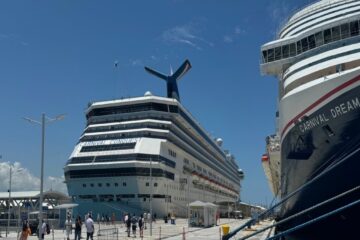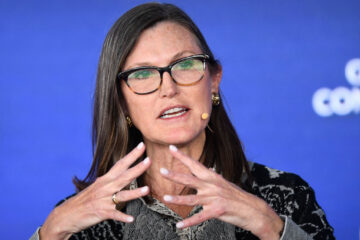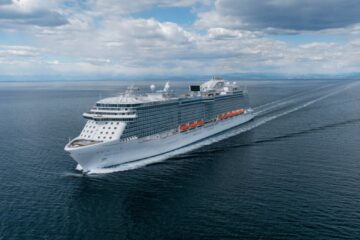With the holiday season upon us, shopping for—and shipping—presents is top of mind.
And while Santa and his reindeer take all the credit for delivering holiday packages through the nighttime skies, in reality, it’s the cargo airlines, like UPS (UPS) , that do most of the heavy lifting.
Every day, UPS aircraft fly 22.3 million packages to every corner of the globe (including the North Pole). While the bulk of the company’s parcels are transported by ground vehicles, like trucks and tractor trailers, air services represent an important part of company operations.
UPS jets travel much longer distances than its ground fleet, which typically have a radius of just 125 miles. UPS’ Next Day Air, 2nd Day Air, and Express Critical services deliver time-sensitive packages, like urgent medical supplies, important or high-value gifts and other items, and perishable goods that can arrive as quickly as the day they’re shipped.
💰💸 Don’t miss the move: SIGN UP for TheStreet’s FREE Daily newsletter 💰💸
Compared to passenger pilots, UPS’ pilots enjoy flexible schedules, increased job stability, and competitive or even higher pay, since there’s more consistent demand in the cargo industry than with commercial airlines.
Recently, the view from the cockpit got even brighter for UPS pilots, thanks to an important new U.S. government contract.
View the original article to see embedded media.
What’s new with UPS pilots?
In April 2024, UPS was awarded a critical new contract from the United States Postal Service (USPS), which ended its 20-year partnership with FedEx (FDX) , the world’s largest express transportation service.
When the new contract took effect in September, UPS became the nation’s primary air cargo provider. A spokesperson for the UPS pilots union, the Independent Pilots Association, told Freightwaves that the company planned to hire more than 300 pilots over the next year in order to support the demand.
Related: FedEx pilot salary: How much does the world’s largest cargo airline pay?
This makes UPS one of the few airlines that is actively hiring pilots. UPS also boasts six-figure pilot salaries that are competitive with commercial airlines, although the advanced skill sets required by candidates probably won’t qualify for the company’s “job offer in 10 minutes” program.
What is UPS Airlines?
UPS pilots fly for UPS Airlines, a subsidiary of the United Parcel Service that was established in the 1980s.
Its air delivery service actually dates as far back as 1929, when UPS packages were simply transported as baggage on commercial flights.
UPS main competitor, FedEx, turned a profit in 1976, thanks in part to the company’s fleet of Boeing 727 jets, which made it clear that delivery services did not need to rely on commercial aircraft to deliver their packages.
FedEx’s cargo freighters were actually decommissioned passenger aircraft—technicians literally removed the galleys, lavatories and rows of seating, swept out old crumbs, reinforced the floors to withstand heavy loads, and configured doorways for cargo loading. It’s a practice the industry continues to use today.
Related: JetBlue pilot salary: What the low-cost airline pays its flight deck
The Airline Deregulation Act of 1978 allowed UPS to establish its own airline, although the company conducted its operations through contractors like Evergreen International Airlines, Interstate Airlines, and Ryan Air through much of the 1980s.
UPS Airlines was founded in 1988 with its main hub in Louisville, Kentucky. Its strategic placement at the western edge of the Eastern time zone allowed UPS to reach most of the continental U.S. in under three hours’ flying time. Later, the company added another distribution facility, in Anchorage, Alaska, which enabled it to get to 90% of the industrialized world in under 10 hours.
Today UPS employs 3,000 pilots and has a total fleet of 500 aircraft: About half are company-owned, and the rest are chartered.
UPS pilots operate Boeing 747, 757, and 767 jets, along with Airbus A300 and McDonnell Douglas MD-11 aircraft. In addition to Louisville, pilots are based out of these U.S. cities:
Atlanta, GeorgiaDallas, TexasOntario, CaliforniaPhiladelphia, PennsylvaniaRockford, Illinois
UPS also operates international air hubs in Miami, Florida, Hamilton, Canada, Cologne, Germany, Taipei, Taiwan, and Shenzhen, China.
View the original article to see embedded media.
What do UPS pilots do?
As the commanders of cargo aircraft, UPS pilots don’t have to interact with passengers. Instead, they safely transport freight and oversee the loading and unloading of cargo. They still have all the typical pilot duties of inspecting the aircraft, recording any issues, planning out the safest and most efficient travel routes, communicating with air traffic control, and operating the aircraft through takeoff, flight, and landing.
For years, airlines had grooming standard policies stating that pilots could not have beards, ostensibly due to safety concerns about whether or not their oxygen masks would fit correctly with facial hair. However, in 2020, UPS relaxed this policy and now allows beards, long hair, and natural Black hairstyles, like Afros and braids, for all of its employees.
Unlike the rest of UPS’ staff, UPS pilots don’t have to wear the company’s brown shorts; rather, they dress in uniforms consisting of a blazer with epaulets, a dress shirt, and a tie. Alternatively, they can switch out the jacket and wear a custom leather bomber jacket from Karbon. Their headgear contains the UPS logo on a center shield framed by gold wings.
How much do UPS pilots make?
UPS pilots are paid based on their years of experience, the aircraft they operate, and the number of hours flown during each bid period. They receive 81 hour monthly and reserve guarantees.
According to the career authority Indeed, which bases its salary estimates on employee surveys and job postings, a UPS pilot makes an average salary of $286,741.
The pay range for a first-year pilot begins around $124,000 and tops out at $515,000. These estimates are roughly in-line with pilot salaries offered at FedEx as well as commercial airlines like United Airlines, Delta Air Lines, and Southwest Airlines, where seasoned captains can mint salaries in the high $300k or $400k range.
Although their salaries are competitive, many people actually think cargo pilots have the better deal than commercial airline pilots, because, well, they don’t actually deal with people.
Cargo pilots also typically spend less time away from home than commercial pilots, due to shorter flying routes; however, they typically fly more nighttime hours than their commercial counterparts.
UPS pilots also enjoy benefits including medical, dental, and vision insurance, paid time off, 401(k) benefits, stock options, and tuition reimbursement—plus they have the opportunity to travel on standby for free, and, arguably, the world’s best office windows.
View the original article to see embedded media.
How long does it take to become a UPS pilot?
Depending on the program they choose, pilot candidates can be on their way toward earning their wings in a year to 36 months. Candidates typically possess a bachelor’s degree and some flying experience prior to enrolling.
More from airlines:
The most delayed (& most on-time) airlines in 2024Frontier vs. Spirit: Which budget airline is better?Flight attendant jobs: Pay, outlook & how to land this competitive role
UPS offers two “FlightPath” programs:
FlightPath I involves a year-long UPS Flight intern position followed by 30 months with its Ameriflight partner program. Upon graduation, pilots receive interviews for the UPS First Officer position.FlightPath II is a 36-month program that breaks down into a 24 month developmental program at Ameriflight, where candidates receive their ATP License, followed by a 30-month Development and Mentorship Program with UPS. Upon completion, these pilots also receive interviews by UPS to become one of their First Officers.
Is UPS hiring pilots?
Yes, UPS is currently hiring pilots on their Careers Page. Pilots who don’t enroll in the FlightPath I or FlightPath II program must hold a current unrestricted ATP certificate, a FAA First Class Medical Certificate, be authorized to work in the U.S., and have a minimum of 1,500 hours of total fixed-wing pilot time, among other requirements.
Related: The 10 best investing books (according to stock market pros)


